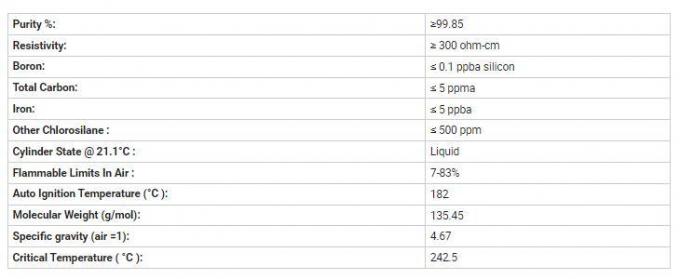


| MOQ: | 1kg |
| Price: | US $500/kg |
| Standard Packaging: | Cylinder/Tank |
| Delivery Period: | 15 days |
| Payment Method: | L/C, T/T |
| Supply Capacity: | 20000 Tons/Year |
Trichlorosilane is a chemical compound composed of one silicon atom bonded to three chlorine atoms and one hydrogen atom. It is a colorless, volatile liquid with a pungent odor. Here are some key points about trichlorosilane:
Chemical Composition: Trichlorosilane consists of one silicon (Si) atom bonded to three chlorine (Cl) atoms and one hydrogen (H) atom. Its chemical formula is HSiCl3.
Properties: Trichlorosilane is a volatile liquid that boils at around 31.8 degrees Celsius (89.2 degrees Fahrenheit) and has a melting point of -68 degrees Celsius (-90.4 degrees Fahrenheit). It has a strong, irritating odor and is highly reactive.
Production: Trichlorosilane is primarily produced through the reaction of metallurgical-grade silicon (obtained from the reduction of silicon dioxide) with hydrogen chloride (HCl) gas:
Si + 3HCl → HSiCl3 + H2
This reaction typically occurs at high temperatures in the presence of a catalyst, such as copper.
Uses: Trichlorosilane has various industrial applications, particularly in the production of silicon-based materials:
Silicon Production: It is a key precursor in the production of polycrystalline silicon, which is widely used in the manufacturing of solar cells, semiconductors, and electronic devices. Trichlorosilane is decomposed at high temperatures to produce silicon.
Chemical Synthesis: Trichlorosilane is used as a starting material or intermediate in the synthesis of various silicon compounds, such as silicones, silanes, and silicon carbide.
Safety Considerations: Trichlorosilane is a hazardous substance and should be handled with caution. It is flammable and can form explosive mixtures with air. Trichlorosilane is also toxic and can cause severe burns upon contact with the skin or eyes. Inhalation of its vapors or fumes can be harmful to the respiratory system. Appropriate safety precautions, such as the use of protective equipment and proper ventilation, should be followed when working with trichlorosilane.
It's important to handle trichlorosilane with care and adhere to safety measures to mitigate potential risks associated with its reactivity and toxicity.
Basic Info.
| Model No: | SiHCl3 | Quality | Electron Grade |
| Transport Package | Y-Cylinder, T-Drum, Tt, Tanker | Specification | 20L, 40L, 280L and customizable |
| Trademark | CMC | Origin | Suzhou, China |
| HS Code | 2812190091 | Production Capacity | 500ton/Month |
Specification:
 Detailed Photo
Detailed Photo
![]()




| MOQ: | 1kg |
| Price: | US $500/kg |
| Standard Packaging: | Cylinder/Tank |
| Delivery Period: | 15 days |
| Payment Method: | L/C, T/T |
| Supply Capacity: | 20000 Tons/Year |
Trichlorosilane is a chemical compound composed of one silicon atom bonded to three chlorine atoms and one hydrogen atom. It is a colorless, volatile liquid with a pungent odor. Here are some key points about trichlorosilane:
Chemical Composition: Trichlorosilane consists of one silicon (Si) atom bonded to three chlorine (Cl) atoms and one hydrogen (H) atom. Its chemical formula is HSiCl3.
Properties: Trichlorosilane is a volatile liquid that boils at around 31.8 degrees Celsius (89.2 degrees Fahrenheit) and has a melting point of -68 degrees Celsius (-90.4 degrees Fahrenheit). It has a strong, irritating odor and is highly reactive.
Production: Trichlorosilane is primarily produced through the reaction of metallurgical-grade silicon (obtained from the reduction of silicon dioxide) with hydrogen chloride (HCl) gas:
Si + 3HCl → HSiCl3 + H2
This reaction typically occurs at high temperatures in the presence of a catalyst, such as copper.
Uses: Trichlorosilane has various industrial applications, particularly in the production of silicon-based materials:
Silicon Production: It is a key precursor in the production of polycrystalline silicon, which is widely used in the manufacturing of solar cells, semiconductors, and electronic devices. Trichlorosilane is decomposed at high temperatures to produce silicon.
Chemical Synthesis: Trichlorosilane is used as a starting material or intermediate in the synthesis of various silicon compounds, such as silicones, silanes, and silicon carbide.
Safety Considerations: Trichlorosilane is a hazardous substance and should be handled with caution. It is flammable and can form explosive mixtures with air. Trichlorosilane is also toxic and can cause severe burns upon contact with the skin or eyes. Inhalation of its vapors or fumes can be harmful to the respiratory system. Appropriate safety precautions, such as the use of protective equipment and proper ventilation, should be followed when working with trichlorosilane.
It's important to handle trichlorosilane with care and adhere to safety measures to mitigate potential risks associated with its reactivity and toxicity.
Basic Info.
| Model No: | SiHCl3 | Quality | Electron Grade |
| Transport Package | Y-Cylinder, T-Drum, Tt, Tanker | Specification | 20L, 40L, 280L and customizable |
| Trademark | CMC | Origin | Suzhou, China |
| HS Code | 2812190091 | Production Capacity | 500ton/Month |
Specification:
 Detailed Photo
Detailed Photo
![]()


